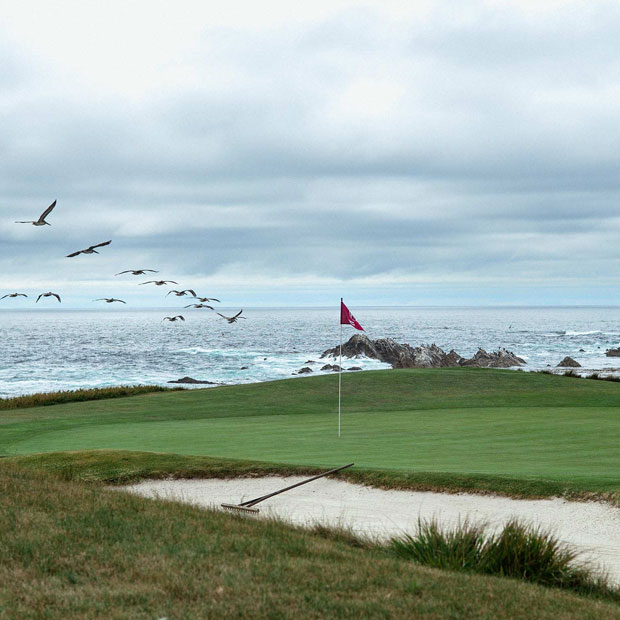Augusta National Golf Club
Ever since it opened, Augusta National has been in a constant state of evolution (for better or for worse), but it remains one of the greatest championship venues in the world

Augusta, Georgia, USA
Alister MacKenzie and Bobby Jones (original design, 1933)
Private
Tom Doak discusses the strategic and penal elements of Augusta National Golf Club's famed Amen Corner.
I Played Augusta National Without My Best Stuff
Five Things About the 2025 Masters with Jaime Diaz
It is the most famous golf course in the world. It is the best inland golf course in the world, arguably — a fun debate for a grill room or patio. Augusta National Golf Club can be notoriously furtive about its movements or who is even working there. But because it hosts the most high-profile golf tournament on Earth every year, more is known about Augusta National, from every slight contour change or sharpened edge, than any golf course.
Augusta National first opened for play in 1933 and hosted the first Masters Tournament in 1934. It is the last Alister MacKenzie design that opened in America before the architect’s death. MacKenzie, the Scottish surgeon who established himself as a “camofleur” by using shaped landforms to conceal fortifications during the Boer War, had worked both in the States and abroad. His courses at Cypress Point and Pasatiempo in California made prominent impressions on the early golf intelligentsia in America. Among them was Bob Jones, co-founder and President in Perpetuity of Augusta National, who collaborated with MacKenzie in laying out the course.
The Old Course influenced MacKenzie and Jones heavily, and they sought to bring its principles of strategic design to create this “inland links.” They emphasized wide playing corridors and wall-to-wall fairways with no rough in order to provide strategic options. The preferred lines are not always clear, but the advantage for finding them, or the challenge resulting from missing them, can quickly become revelatory. The opportunity for recovery still exists from a less preferred line in a fairway, but the challenge is greater and the penalty for not pulling it off even more severe and compounding. The renowned Jones summation still rings out: “We want to make bogeys easy if frankly sought, pars readily obtainable by standard good play, and birdies — except on par 5s — dearly bought.”
MacKenzie had built a reputation for theatrics in building greens and bunkers, and that was a point of emphasis at Augusta National. The drama peaked at his audacious greens, revealing the options for a range of heroic or disastrous outcomes. After MacKenzie’s work in California, Augusta National represented the next phase of his career, one in which he resolved to push creative green design even further. Speaking on the Fried Egg Golf podcast, historian Bob Crosby called these efforts “strategic golf course architecture on LSD.”
Several of MacKenzie’s greens remain, and the masterful routing conjured up with Jones is largely intact, even after the nines were flipped following the first Masters. Augusta National lays across one larger hill, cascading from the clubhouse down to the farthest points of Amen Corner. But within it are several smaller hills and dips that the routing uses continually, creating uneven lies for approaches to different elevations, such as the climb up the eighth or the drop down to the 15th. Mackenzie was an expert at creating multiple meeting points, using a feature or two to anchor multiple holes. The large hill where the second, seventh and 17th greens sit is one example, with the 18th, 8th, and third tee boxes nearby. There is a reason the scoreboard behind the seventh green is a common meeting point for phone-less patrons. You can quickly get anywhere out on the course from that central point. There are very few places — the fifth tee perhaps being one — that feel removed and isolated in this routing.
MacKenzie brought his dramatic bunker style to Augusta National, but, in concert with Jones, showed restraint in numbers, with only 22 bunkers on the original design, relying more on the contours of the land to create both hazard and escape in and around the bold greens. This led to a course that could still be both challenging to the elite golfer of the Masters while playable and fun for the average golfer, a dynamic that persists today.
Of course, the number of bunkers grew over the years and their aesthetics changed. The only constant at Augusta National is change. Golf writer and Jones confidante Charles Price said the course was not the most “revolutionary” in America, but rather “the most evolutionary.” Certain critics would suggest that even calling this a MacKenzie design is misleading.
Indeed, the number of architects and consulting voices who have “worked” with the club over the years numbers in the double digits. Perry Maxwell, who served as MacKenzie’s associate on several projects in the Midwest, was the first and most prominent architect to work at Augusta National after MacKenzie’s death in 1934. Maxwell made several changes to greens, rebuilding and re-bunkering them, and most significantly moved the greens at the seventh and 10th holes, pushing them back up on their respective hills.
Robert Trent Jones was the primary architect to work at the club in the postwar era, building the new and modern-day 16th hole and lengthening the 11th hole. Tom Fazio worked with the club starting in the late 90s, often adding more length, most notably on the seventh hole. And then there was the Tiger-proofing era at the start of the 21st century, when trees were added — such as at the 11th, 15th, and 17th holes — and a rough cut implemented with greater frequency. These efforts constricted the original vision of strategic design by MacKenzie and Jones, with the tree clusters eliminating certain positions of attack into the greens. The rough stopped mishits from cascading further offline into something more treacherous, and also mitigated some of the spin control that is requisite into these wildly undulating greens. Tiger Woods was critical of the rough and narrowing, writing that it “eroded strategic values that Bobby Jones and Alister MacKenzie had created as the course’s essential feature.”
The work continues on an almost annual basis. Some of the most recent changes have been targeted at reclaiming some of the width at the 11th hole and taking out some of the “second cut” rough. While the lengthening continues in an effort to keep up with the massive distance gains by those playing the Masters, the member tees remain at 6,300 yards and the course exceedingly playable. As Jones wrote, “The first purpose of any golf course should be to give pleasure, and that to the greatest possible number of players, without respect to their abilities.”
{{content-block-course-profile-augusta-national-golf-club-001}}
Take Note...
Routing changes. The first hole, as we know it today, was the first hole when Augusta National opened, but prior to the inaugural Masters, the nines were flipped, making the first the 10th, and vice versa. This routing was abandoned after the tournament and returned to its current sequence.
Not original. As Brendan mentions in his introduction above, a few of Augusta National’s holes have seen significant changes over the years, particularly the seventh, 10th, and 16th. Each of these now features completely different green sites than they initially did. The seventh and 10th greens were moved from low areas to ridges by Perry Maxwell in the 1930s, and the 16th was completely redesigned by Robert Trent Jones in the late 40s.
Never built. In the early 1930s, Alister MacKenzie created a plan for a reversible short course at Augusta National, but it was never built. In 1958, the club opened a par-3 course designed by George Cobb and Clifford Roberts. That course was renovated to create better spectator flow in 2023.
A sad ending. Building Augusta National was an ambitious endeavor at the height of the Great Depression. As a result, the club struggled financially in its early days, never paying Alister MacKenzie his full design fee. The architect died a few months before the playing of the first Masters and did not get to see the finished version of the course
Atlanta’s Augusta. Atlanta’s favorite son, Bobby Jones, had a hand in the design of one other golf course: Peachtree Golf Club in Atlanta. There, he collaborated with Robert Trent Jones to create Atlanta’s premiere course. Jones’s role in designing Peachtree’s greens seems evident; many possess bold contouring similar to Augusta National’s and a far cry from much of RTJ’s solo work.
Favorite Hole
No. 14, par 4, 440 yards
My favorite hole at Augusta National is a moving target; I have about seven. Today, I’ll settle on the 14th, with its epic green. The green sits on the severe sideslope of Augusta National’s main hill, so it cascades down from left to right, but it manages the tilt with three distinct tiers. Like the green, the fairway slopes considerably from left to right, which means that many approaches will have a left-to-right shape. Even “good shots” with this shape may filter down to lower tiers or get rejected by the vicious false front, leaving challenging two putts.
Also, No. 14 is the only bunker-less hole at Augusta National, and I just love the simplicity of bunker-less holes.
Favorite Hole
No. 14, par 4, 440 yards
My favorite hole at Augusta National is a moving target; I have about seven. Today, I’ll settle on the 14th, with its epic green. The green sits on the severe sideslope of Augusta National’s main hill, so it cascades down from left to right, but it manages the tilt with three distinct tiers. Like the green, the fairway slopes considerably from left to right, which means that many approaches will have a left-to-right shape. Even “good shots” with this shape may filter down to lower tiers or get rejected by the vicious false front, leaving challenging two putts.
Also, No. 14 is the only bunker-less hole at Augusta National, and I just love the simplicity of bunker-less holes.

{{content-block-course-profile-augusta-national-golf-club-002}}
Overall Thoughts
Describing the architecture of Augusta National and all of its virtues could take up an entire book. As initially designed by Alister MacKenzie and Bobby Jones, the course represented a new set of ideas about golf architecture. It had eccentrically shaped features and minimal bunkering, setting it apart from most courses built in the 1920s and 30s. But above all, MacKenzie and Jones’s design was radical in its attempt to apply the principles of The Old Course at St. Andrews to an inland site. The most important of these principles was that the course should be playable for all yet challenging for the best golfers in the world. Through the years, the club has been able to maintain this balance, despite the distance explosion at the elite levels of the game. This is in part thanks to the club’s ability to make annual changes and expand its footprint, but it is also due to the timeless strengths of the course’s architecture and property.
One could argue that some recent setup and design decisions have lessened the course’s playability for average golfers. Yet Augusta National remains one of the world’s best examples of a tournament venue that also functions well as a member course. This is a testament to a few different factors: a brilliant routing over a severe piece of land, an exceptional set of greens, and an array of strategically sound golf holes.
Routing
From the start, MacKenzie and Jones’s goal was to make Augusta National the world’s greatest inland course. This was a tall order, considering that the property is not what any architect would deem ideal for golf. It is very severe, with over 150 feet of elevation change from the clubhouse to the property’s low point at Amen Corner. On this kind of land, it’s hard to create a golf course with a cohesive flow. Going downhill can be dramatic, but coming back up can be a slog. This is why the vast majority of great golf courses have between 20 and 80 feet of elevation change.
While the severity of the land presented a challenge to Jones and MacKenzie, it also offered an opportunity to create the type of dramatic and memorable holes usually reserved for seaside settings. For first-time attendees of The Masters, the drama of the property is almost always the biggest shock. Stringing together 18 great holes on this terrain, while also making the course walkable, was an impressive feat of design.
The basic theme of the routing is two nines that spiral downhill before tacking their way back up. On each side, the routing navigates the hill differently. The majority of the downslope on the front nine is tackled by the plunging par-5 second. From there, as Geoff Shackelford has previously noted, the key to the routing is the way that the two par 3s — the fourth and sixth holes — manage the most abrupt sections of a valley that runs through the site. By getting to the other side of this valley (and back), Jones and MacKenzie unlocked the opportunity to use some of Augusta National’s best topography, where today’s fifth hole resides. This hole plays beautifully along a high ridge, which lends this part of the course some needed variety. Rather than just playing downhill and back up, the front nine descends into the valley, bounces back above it on the fifth, then drops back in on the sixth. Then the eighth hole takes players straight up before the ninth quickly dips down and back up.
{{content-block-course-profile-augusta-national-golf-club-003}}
It is also important to note how cleverly the eighth hole is situated. In the routing, it serves the purpose of surmounting a severe hill, but it gives this topographical feature a strategic purpose: players who hit a good, aggressive tee shot will be far more able to get over the hill with their second shot than those who don’t.
The back nine wastes no time dropping back into the valley, plummeting 100 feet on the 10th hole and continuing the descent on the 11th. From there, Augusta’s longer holes can use the lower and less severe portion of the hill — a dynamic not as present on the front nine. Nos. 13, 14, and 17 use sidehill design concepts while pulling players up a significant portion of the slope. The 14th and 17th holes, in particular, subtly move uphill without seeming like obvious climbs in the manner of the eighth and 18th. The back nine’s journey down and back up has its own distinctive structure and feeling.
Beyond the function of moving players up and down the hill, Augusta National’s routing also has a cohesive ebb and flow. Like a well-told story, the course immediately hooks the player’s interest with the dramatic second and then proceeds through different peaks and valleys, both literal and figurative. The drama hits a high point in the middle of the back nine with Amen Corner and the encounter with the property’s most stunning setting, Rae’s Creek. The course then builds toward its resolution, with the thrilling make-or-break second shot on the 15th and a tough closing duo in Nos. 17 and 18.
Greens
Architect and “grandfather of American golf” C.B. Macdonald once wrote, “Putting greens to a golf course are what the face is to a portrait.” Creating a unique “face” for a hole starts with finding the right location, and this is something MacKenzie and Jones — as well as Perry Maxwell, with his 1930s renovations — did extraordinarily well at Augusta National. The course’s green sites are beautiful, diverse, and rarely repetitive.
{{content-block-course-profile-augusta-national-golf-club-004-quote}}
I have written a great deal about Augusta National’s greens over the years, but the key words that always come to my mind are “variety” and “versatility.” The variety of locations that MacKenzie, Jones, and Maxwell found for the greens demands a wide range of shots from players. Just consider the first three holes. On the opener, you play to a propped-up target that rejects slightly inaccurate shots. The second presents a downhill approach to a ground-hugging green that accepts a running shot. Finally, the third sits on a lovely natural ridge that deflects balls into a hollow short left, making players think twice about being aggressive off the tee.
{{content-block-course-profile-augusta-national-golf-club-004}}
In addition to variety, Augusta’s greens possess great versatility thanks to their large size and constant undulation. Through shape, orientation, and contour, these greens give tremendous advantages to those who play from certain positions in the fairway. These positions could be considered the day’s “lines of charm” off the tee, and to find them, players need to pair power with precision.
Strategic design
The secret sauce of MacKenzie and Jones’s design is the combination of the greens, the land, and the minimal bunkering to create intricate strategic scenarios. Some of this strategy has been muted by excessive tree planting, but much of it remains today. Augusta National’s design still stands out for the way it operates in shades of gray. So many championship golf courses offer black-and-white scenarios: hit the fairway, good; miss the fairway, bad. At Augusta National, there are certainly preferred lines off the tee, but they change from day to day, depending on pin position. Every yard that you deviate from those lines presents a different shade of gray. Because of its width and severe green contouring, Augusta National is able to make opposite sides of the same fairway feel and play dramatically different from each other.
Consider the iconic 13th hole, where the green’s orientation next to the tributary of Rae’s Creek and its contouring give a distinct advantage to a shot coming in from the left side of the fairway. This advantage is supercharged by the natural topography: the fairway slopes sharply from right to left, but near the creek it is flatter. The left side, therefore, offers both the best angle and the flattest lie. As you stray away from that ideal location, the gray gets darker as the slope grows more severe and the approach angle becomes better. However, since this higher position is farther away from the creek, the tee shot itself is far safer.
{{content-block-course-profile-augusta-national-golf-club-005}}
The 13th, like many holes at Augusta National, tests a golfer’s appetite for risk. As soon as you start playing safe, pars can become hard to come by. In order to give yourself the best chance of a birdie, you have to take on some degree of danger. If you choose this more aggressive tactic and pull it off with regularity, the benefits are stark: suddenly you’re able to find the small pinnable areas, and the big contours of the greens help you instead of hurting you.
Throughout the golf course, players are faced with these micro-decisions involving shades of gray and opportunities to pursue rewards by taking on risk. Tom Doak has said that Pete Dye often remarked that the key to challenging tour players was to get them to think. Augusta National engages the player’s golf IQ on almost every shot. It is the thinking man’s championship golf course, and that is the source of its enduring relevance.
3 Eggs
Augusta National is a tough course to rate. Do I believe that the current presentation of the course gets the most out of the design? No. But are there five golf courses I think about more? Also, no. Despite straying away from MacKenzie and Jones’s original design in many respects, Augusta National simply is a three-Egg course, and I can’t in good faith rate it lower. The sheer number of factors that have to be considered on each shot is unparalleled in golf. So here’s my question: if Augusta National underwent a balanced renovation that brought back some of MacKenzie’s stylistic flair while still making accommodations for the modern championship game, would it be hands down the best golf course in the world?
The About section of this course profile was written by Brendan Porath. The rest was written by Andy Johnson.
Course Tour

{{content-block-course-profile-augusta-national-golf-club-006}}
Some of our favorite Augusta National related content
I Got Ejected at Augusta National (Article)
What I Learned From My Lottery Round at Augusta National (Article)
Art Behind the Roars at Augusta National (Article)
No. 13 at Augusta National: A Postmortem (Article)
All 18 Holes at Augusta National with Geoff Ogilvy (Fried Egg Golf Podcast)
Great Courses: Augusta National (Fried Egg Golf Podcast)
Tom Doak discusses the strategic and penal elements of Augusta National Golf Club's famed Amen Corner.
Leave a comment or start a discussion
Get full access to exclusive benefits from Fried Egg Golf
- Member-only content
- Community discussions forums
- Member-only experiences and early access to events





























Leave a comment or start a discussion
Lorem ipsum dolor sit amet, consectetur adipiscing elit. Suspendisse varius enim in eros elementum tristique. Duis cursus, mi quis viverra ornare, eros dolor interdum nulla, ut commodo diam libero vitae erat. Aenean faucibus nibh et justo cursus id rutrum lorem imperdiet. Nunc ut sem vitae risus tristique posuere. uis cursus, mi quis viverra ornare, eros dolor interdum nulla, ut commodo diam libero vitae erat. Aenean faucibus nibh et justo cursus id rutrum lorem imperdiet. Nunc ut sem vitae risus tristique posuere.